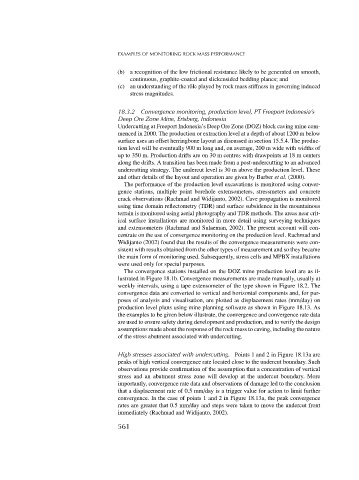Page 579 - Rock Mechanics For Underground Mining
P. 579
EXAMPLES OF MONITORING ROCK MASS PERFORMANCE
(b) a recognition of the low frictional resistance likely to be generated on smooth,
continuous, graphite-coated and slickensided bedding planes; and
(c) an understanding of the rˆole played by rock mass stiffness in governing induced
stress magnitudes.
18.3.2 Convergence monitoring, production level, PT Freeport Indonesia’s
Deep Ore Zone Mine, Ertsberg, Indonesia
Undercutting at Freeport Indonesia’s Deep Ore Zone (DOZ) block caving mine com-
menced in 2000. The production or extraction level at a depth of about 1200 m below
surface uses an offset herringbone layout as discussed in section 15.5.4. The produc-
tion level will be eventually 900 m long and, on average, 200 m wide with widths of
up to 350 m. Production drifts are on 30 m centres with drawpoints at 18 m centers
along the drifts. A transition has been made from a post-undercutting to an advanced
undercutting strategy. The undercut level is 30 m above the production level. These
and other details of the layout and operation are given by Barber et al. (2000).
The performance of the production level excavations is monitored using conver-
gence stations, multiple point borehole extensometers, stressmeters and concrete
crack observations (Rachmad and Widijanto, 2002). Cave propagation is monitored
using time domain reflectometry (TDR) and surface subsidence in the mountainous
terrain is monitored using aerial photography and TDR methods. The areas near crit-
ical surface installations are monitored in more detail using surveying techniques
and extensometers (Rachmad and Sulaeman, 2002). The present account will con-
centrate on the use of convergence monitoring on the production level. Rachmad and
Widijanto (2002) found that the results of the convergence measurements were con-
sistent with results obtained from the other types of measurement and so they became
the main form of monitoring used. Subsequently, stress cells and MPBX installations
were used only for special purposes.
The convergence stations installed on the DOZ mine production level are as il-
lustrated in Figure 18.1b. Convergence measurements are made manually, usually at
weekly intervals, using a tape extensometer of the type shown in Figure 18.2. The
convergence data are converted to vertical and horizontal components and, for pur-
poses of analysis and visualisation, are plotted as displacement rates (mm/day) on
production level plans using mine planning software as shown in Figure 18.13. As
the examples to be given below illustrate, the convergence and convergence rate data
are used to ensure safety during development and production, and to verify the design
assumptions made about the response of the rock mass to caving, including the nature
of the stress abutment associated with undercutting.
High stresses associated with undercutting. Points 1 and 2 in Figure 18.13a are
peaks of high vertical convergence rate located close to the undercut boundary. Such
observations provide confirmation of the assumption that a concentration of vertical
stress and an abutment stress zone will develop at the undercut boundary. More
importantly, convergence rate data and observations of damage led to the conclusion
that a displacement rate of 0.5 mm/day is a trigger value for action to limit further
convergence. In the case of points 1 and 2 in Figure 18.13a, the peak convergence
rates are greater that 0.5 mm/day and steps were taken to move the undercut front
immediately (Rachmad and Widijanto, 2002).
561

